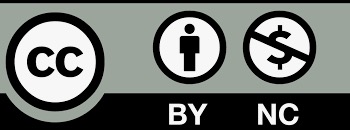Published
2024-11-21
Section
Research Articles
License
The journal adopts the Attribution-NonCommercial 4.0 International (CC BY-NC 4.0), which means that anyone can reuse and redistribute the materials for non-commercial purposes as long as you follow the license terms and the original source is properly cited.
Author(s) shall retain the copyright of their work and grant the Journal/Publisher rights for the first publication with the work concurrently licensed since 2023 Vol.8 No.2.
Under this license, author(s) will allow third parties to download, reuse, reprint, modify, distribute and/or copy the content under the condition that the authors are given credit. No permission is required from the authors or the publisher.
This broad license intends to facilitate free access, as well as the unrestricted use of original works of all types. This ensures that the published work is freely and openly available in perpetuity.
By providing open access, the following benefits are brought about:
- Higher Visibility, Availability and Citations-free and unlimited accessibility of the publication over the internet without any restrictions increases citation of the article.
- Ease of search-publications are easily searchable in search engines and indexing databases.
- Rapid Publication – accepted papers are immediately published online.
- Available for free download immediately after publication at https://esp.as-pub.com/index.php/ESP

Copyright Statement
1.The authors certify that the submitted manuscripts are original works, do not infringe the rights of others, are free from academic misconduct and confidentiality issues, and that there are no disputes over the authorship scheme of the collaborative articles. In case of infringement, academic misconduct and confidentiality issues, as well as disputes over the authorship scheme, all responsibilities will be borne by the authors.
2. The author agrees to grant the Editorial Office of Environment and Social Psychology a licence to use the reproduction right, distribution right, information network dissemination right, performance right, translation right, and compilation right of the submitted manuscript, including the work as a whole, as well as the diagrams, tables, abstracts, and any other parts that can be extracted from the work and used in accordance with the characteristics of the journal. The Editorial Board of Environment and Social Psychology has the right to use and sub-licence the above mentioned works for wide dissemination in print, electronic and online versions, and, in accordance with the characteristics of the periodical, for the period of legal protection of the property right of the copyright in the work, and for the territorial scope of the work throughout the world.
3. The authors are entitled to the copyright of their works under the relevant laws of Singapore, provided that they do not exercise their rights in a manner prejudicial to the interests of the Journal.
About Licence
Environment and Social Psychology is an open access journal and all published work is available under the Creative Commons Licence, Authors shall retain copyright of their work and grant the journal/publisher the right of first publication, and their work shall be licensed under the Attribution-NonCommercial 4.0 International (CC BY-NC 4.0).
Under this licence, the author grants permission to third parties to download, reuse, reprint, modify, distribute and/or copy the content with attribution to the author. No permission from the author or publisher is required.
This broad licence is intended to facilitate free access to and unrestricted use of original works of all kinds. This ensures that published works remain free and accessible in perpetuity. Submitted manuscripts, once accepted, are immediately available to the public and permanently accessible free of charge on the journal’s official website (https://esp.as-pub.com/index.php/ESP). Allowing users to read, download, copy, print, search for or link to the full text of the article, or use it for other legal purposes. However, the use of the work must retain the author's signature, be limited to non-commercial purposes, and not be interpretative.
Click to download <Agreement on the Licence for the Use of Copyright on Environmental and Social Psychology>.
How to Cite
Necessity of Setting up Intelligent Maritime Course in China's Undergraduate Major in Navigation Technology
Hui Wang
Hainan Vocational University of Science and Technology,Haikou 571126, China
Aimin Wei
Hainan Vocational University of Science and Technology,Haikou 571126, China
Donglou Li
Hainan Vocational University of Science and Technology,Haikou 571126, China
Congjin Miao
Hainan Vocational University of Science and Technology,Haikou 571126, China
DOI: https://doi.org/10.59429/esp.v9i10.3122
Keywords: intelligent navigation course, navigation technology education in China, evaluation method
Abstract
The maritime industry is at the forefront of a technological revolution with the advent of intelligent ships, which integrate modern information technology and artificial intelligence. Disclosed by Clarkson Reserach from 2019-2023,over the past five years, more than 95% of global ship construction has been dominated by China, South Korea, and Japan, with nearly 100% of new builds incorporating these advanced technologies. This rapid integration underscores the urgency for future maritime professionals to acquire management skills specific to intelligent ships. With China leading the charge with over 50% of the world's annual shipbuilding completion, it is of paramount importance to integrate intelligent maritime courses into the undergraduate navigation curriculum in China, including both academic and vocational education. This paper leverages big data descriptive analysis from global annual shipbuilding completion to argue for the necessity of incorporating intelligent navigation courses in undergraduate majors within China's navigation technology education.
The descriptive analysis of big data is the analysis of various characteristics of a set of data in order to describe the characteristics of the measurement sample and the overall characteristics it represents,and to reveal the characteristics with charts, curves and other visual methods, provide advice and reference to user when making decision .
It discusses the current state of navigation technology education, the importance of aligning curriculum with industry development, and the challenges and strategies for implementing intelligent navigation courses. The paper also explores the role of software and technology in these courses, the significance of industry collaboration, and the methods for evaluating and continuously improving the curriculum.
References
[1]. Demirel, E. (2020). Maritime education and training in the digital era. Universal Journal of Educational Research. pirireis.edu.tr
[2]. El-Sheimy, N. & Li, Y. (2021). Indoor navigation: State of the art and future trends. Satellite Navigation. springer.com
[3]. Osaloni, O. S. & Ayeni, V. O. (2022). The development of maritime autonomous surface ships: regulatory challenges and the way forward. Beijing L. Rev. scirp.org
[4]. Chuah, L. F., Mohd Salleh, N. H., Osnin, N. A., Alcaide, J. I., Abdul Majid, M. H., Abdullah, A. A., ... & Klemeš, J. J. (2021). Profiling Malaysian ship registration and seafarers for streamlining future Malaysian shipping governance. Australian Journal of Maritime & Ocean Affairs, 13(4), 225-261. researchgate.net
[5]. Aslam, S., Michaelides, M. P., & Herodotou, H. (2020). Internet of ships: A survey on architectures, emerging applications, and challenges. IEEE Internet of Things journal, 7(10), 9714-9727. researchgate.net
[6]. Zhang, X., Wang, C., Jiang, L., An, L., & Yang, R. (2021). Collision-avoidance navigation systems for Maritime Autonomous Surface Ships: A state of the art survey. Ocean Engineering. ljmu.ac.uk
[7]. Dai, K., Lingard, B., & Musofer, R. P. (2020). Mobile Chinese students navigating between fields:(Trans) forming habitus in transnational articulation programmes? Educational Philosophy and Theory. academia.edu
[8]. Kamola-Cieślik, M. (2021). Changes in the global shipbuilding industry on the examples of selected states worldwide in the 21st century. European Research Studies. ersj.eu
[9]. Lu, F., Zhou, H., Guo, L., Chen, J., & Pei, L. (2021). An ARCore-based augmented reality campus navigation system. Applied Sciences. mdpi.com
[10]. Deling, W., Dongkui, W., Changhai, H., & Changyue, W. (2020). Marine autonomous surface ship-a great challenge to maritime education and training. American Journal of Water Science and Engineering, 6(1), 10-16. researchgate.net
[11]. van Westrenen, F., & Baldauf, M. (2020). Improving conflicts detection in maritime traffic: Case studies on the effect of traffic complexity on ship collisions. Proceedings of the Institution of Mechanical Engineers, Part M: Journal of Engineering for the Maritime Environment, 234(1), 209-222. sagepub.com
[12]. de Água, P. M. G. B., da Silva Frias, A. D., Carrasqueira, M. D. J., & Daniel, J. M. M. (2020). Future of maritime education and training: blending hard and soft skills. Pomorstvo, 34(2), 345-353. srce.hr
[13]. Ma, X., Huang, J., Wang, R., & Shi, Y. (2024). China-ASEAN Free Trade Port from a Global Perspective: International Cooperation Mechanism for Maritime Vocational Education. Advances in Vocational and Technical Education, 6(4), 22-29. clausiuspress.com
[14]. Jamil, M. G., & Bhuiyan, Z. (2021). Deep learning elements in maritime simulation programmes: a pedagogical exploration of learner experiences. International Journal of Educational Technology in Higher Education, 18(1), 18. springer.com
[15]. Hung, D. V., Oanh, D. T., Giang, N. D. H., Toan, L. T., & Duc, N. M. (2024). Developing self-learning abilities for students in the context of the Covid-19 pandemic: A case study in Vietnam. allmultidisciplinaryjournal.com







